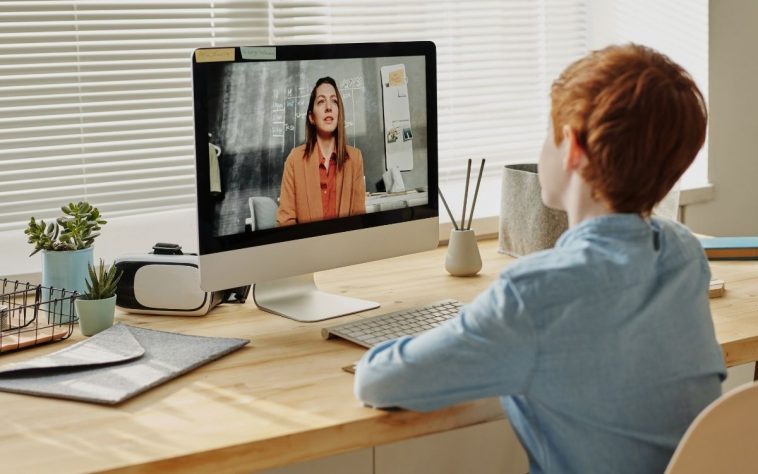Throughout the COVID-19 pandemic, students and educators alike have had to make the shift to online learning to ensure the safety and health of those around them. Now in 2022 with COVID-19 and its variants still present, Zoom has been the frequently used communication platform for teachers to continue providing education to students. What are the pros and cons of Zoom for education?
Some of the pros of Zoom for education are the accessibility to connect with students in various locations, easier for parents and students to contact teachers individually, and the flexibility to screen share & record the lessons. A few cons to Zoom for education are the lack of personal connections students may have with the teachers, the limitations of certain course activities, class involvement and attendance, and the access to a readily available internet connection.
Pro: Allows Students to Connect From Anywhere

A benefit of Zoom for education is that Zoom enables students who live in different areas with no access to transportation to participate in classes. It allows for students in different states or countries to enroll in the school’s program and join courses virtually through Zoom. The free Zoom plan supports up to 100 participants, while the enterprise-level plan can host up to 500 participants.
The ability to connect students from all over into one class is a fantastic way to utilize technology and its communication systems. The ability to bring 100+ students and teachers into one space is a great way to bring forward various viewpoints, collaborations, and connections from different people, cultures, and values.
The ability to connect from anywhere using Zoom gives students a higher chance at advanced academic success for students’ journeys outside of the classroom and into their communities.
Related: What are the Pros of Online Classes?
Pro: Several Ways to Communicate With Teachers
Digital spaces like Zoom allow teachers to utilize several different communication methods. Teachers can give feedback and information to students individually, Teachers can grade and assign work digitally as well.
Zoom for education allows for direct contact with teachers either in a public chat during the virtual meetings or in private via email or direct message. Students and teachers can ask or answer questions about assignments on the message board or in chat boxes. This option is beneficial for those students that may have been hesitant to speak in class and fully participate because of the attention that comes with talking in a group setting. But students can feel comfortable asking questions and commenting on the content without the pressure of other students.
Teachers can set up an individual Zoom meeting like office hours to answer questions students may have to allow for a greater connection between students and teachers without the physical act of meeting. All these options allow for students to talk with their teacher one-on-one, give students the confidence to speak and participate in class and create a learning environment where students are heard for more opportunities than a physical classroom may provide.
Pro: Screen Share
The screen sharing option of Zoom is very useful and beneficial for both educators and learners. Zoom is there to enable the feature of showing the presenter on one screen as well as a presentation on other screens. This feature provides a great advantage in education because it gives teachers and presenters the options to showcase materials and information to all the students at once.
The teacher can control which piece of information is on the screen and what is meant to be highlighted for the students. that brings plenty of possibilities. A presenter or teacher can use this feature when demonstrating instruction for students if students have trouble navigating the digital content.
Related: How Does a Document Camera Help Students?
Pro: Recorded Lessons

Another feature that can be used on Zoom for education is the record feature. The recorded feature is extremely beneficial and advantageous because meetings and lessons can be recorded for later use by the teacher or students that were not able to attend the live meetings. Teachers can effectively record live classes and lectures for future purposes and needs.
Each of the recordings is able to be stored on the device used, which can then be uploaded later on the cloud for other students to access. This feature is probably the most beneficial to virtual learning because students will have access to the information shared on the recording to use for studying or answering any questions that students may have if they were not able to attend live meetings.
Related: What are the Pros and Cons of Virtual Learning?
Con: Lack of Personal Connection
Although Zoom has several features that are almost similar to a face-to-face classroom environment, Zoom for education lacks essential tools that can help teachers build the ideal classroom environment. Zoom for education is more focused on teacher-centered speaking and giving information to students rather than a collaboration with teachers and students. If a teacher’s teaching style is more shaped by students’ feedback, communication, and hands-on engagement, then Zoom for education may be difficult for them to use.
Though Zoom for education can give students and teachers a chance to engage and interact one-on-one, there can also be a lack of personal connection that comes with it. The lack of personal connection can be an issue because teachers won’t have the cultural competency to fully understand the students that are participating in their classes. If the structure of the Zoom class is mainly teacher-centered and the time spent one-on-one is confined to office hours, the teacher’s ability to connect personally with students is limited.
Con: Limitation to Class Activity
Another con to Zoom for education would be that lessons taught virtually do not provide the same level of involvement with the class activity compared to an in-person classroom environment. In a classroom environment, teachers would be able to plan lessons that could get students to actively participate in the lesson by forming groups, conducting hands-on activities, or taking class trips. In a virtual class, the teacher has limited options of class activities that can be achieved with students and teachers on a computer. Granted, various class trips can take form with having speakers or virtual tours, but the experience that is had with in-person activity can be a greater benefit to students’ academic journeys.
Con: Lower Class Attendance and Involvement

With the limit of class activity and hands-on opportunities comes the possibility of lower class attendance and involvement. With Zoom for education, there isn’t a guarantee students will feel motivated to join the virtual lessons, thus class attendance may be lower than the typical classroom meetings. Though attendance may differ depending on the subject of the class and the instructor’s teaching style. Great class attendance may not be achieved or obtained because students may not feel motivated or inspired by the structure of the class.
Students may also not have any structure or discipline at home or in their lives that encourages them to attend the classes virtually. This can be especially true for young students that depend on their guardians to set up computers to connect with the teachers. All of these factors play an important role in not only conducting a virtual class but having the class sustain attendance and involvement with the students.
Related: 11 of the Best Gadgets for Teaching and Learning
Con: A Disadvantage for Low-Income Families
The disadvantage to Zoom for education here is that not everyone has access to a computer or a stable high-speed internet connection at home.
The Los Angeles Times surveyed 45 public school districts across Southern California and reported, “Students in districts serving low-income areas were less likely on average to have a computing device or adequate internet access at home when schools closed”.
This is a similar experience for many students throughout the country, especially students living in rural areas or those in low-income housing that may not have computers or fast internet speed at their disposal. The only way a Zoom for education can work for students is if they have the materials and means to connect online. This is the biggest con to Zoom for education, and with situations increasing and the need for virtual learning increases, access to technology for students’ education should be a priority.
Final Thoughts – Pros and Cons of Zoom For Education
Overall, Zoom for education has allowed many teachers to continue teaching and students to continue their education even when the ability to meet in person has been restricted. Zoom has allowed educators to be creative and intuitive in the ways they can teach students and craft a new way to engage and teach lessons with the Zoom platform.
But Zoom for education is not for everyone. As was just shared, Zoom for education can limit the personal connections that can be created in a classroom. This lack of connection can form a dynamic of speaker and listener rather than a collaboration of learning. Zoom for education can limit class participation and activity because of the restriction virtual learning creates. As well as creating a disadvantage to families and homes that may not have computers or internet at all.
All of these factors can be discussed and considered when utilizing Zoom for education. Though circumstances may prevent education from being taught in person, educators and teachers always have the option to expand and teach virtually through Zoom.




